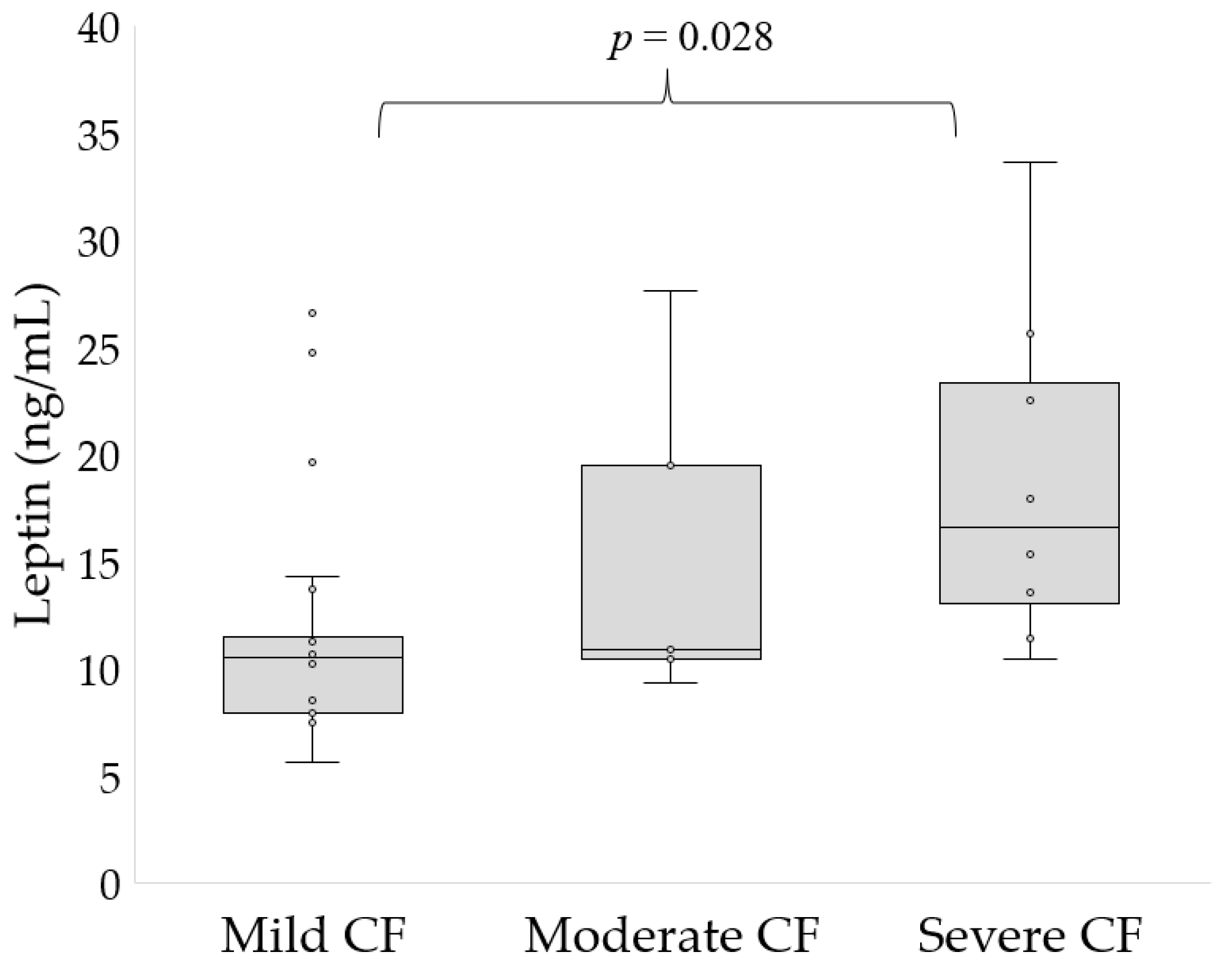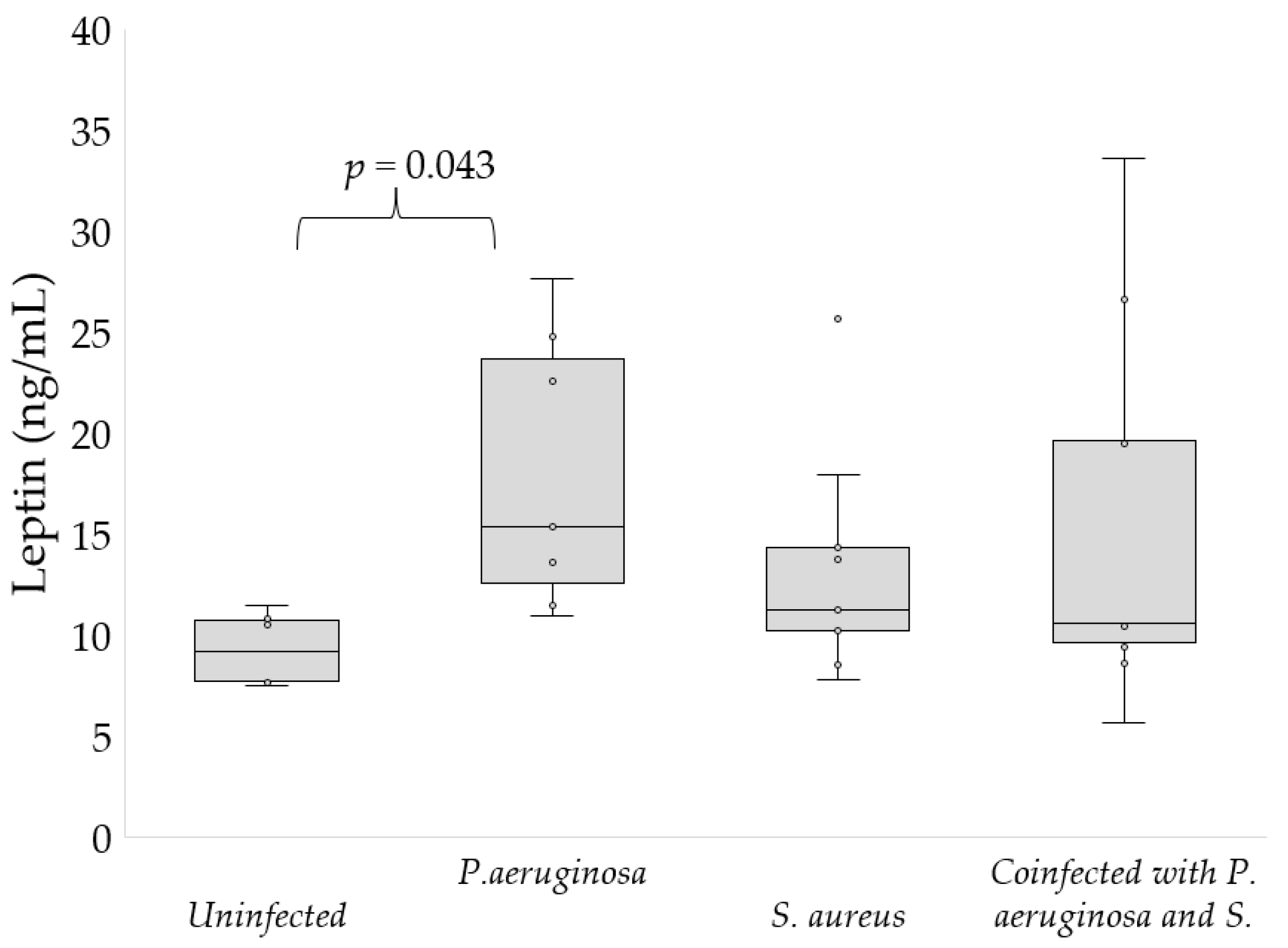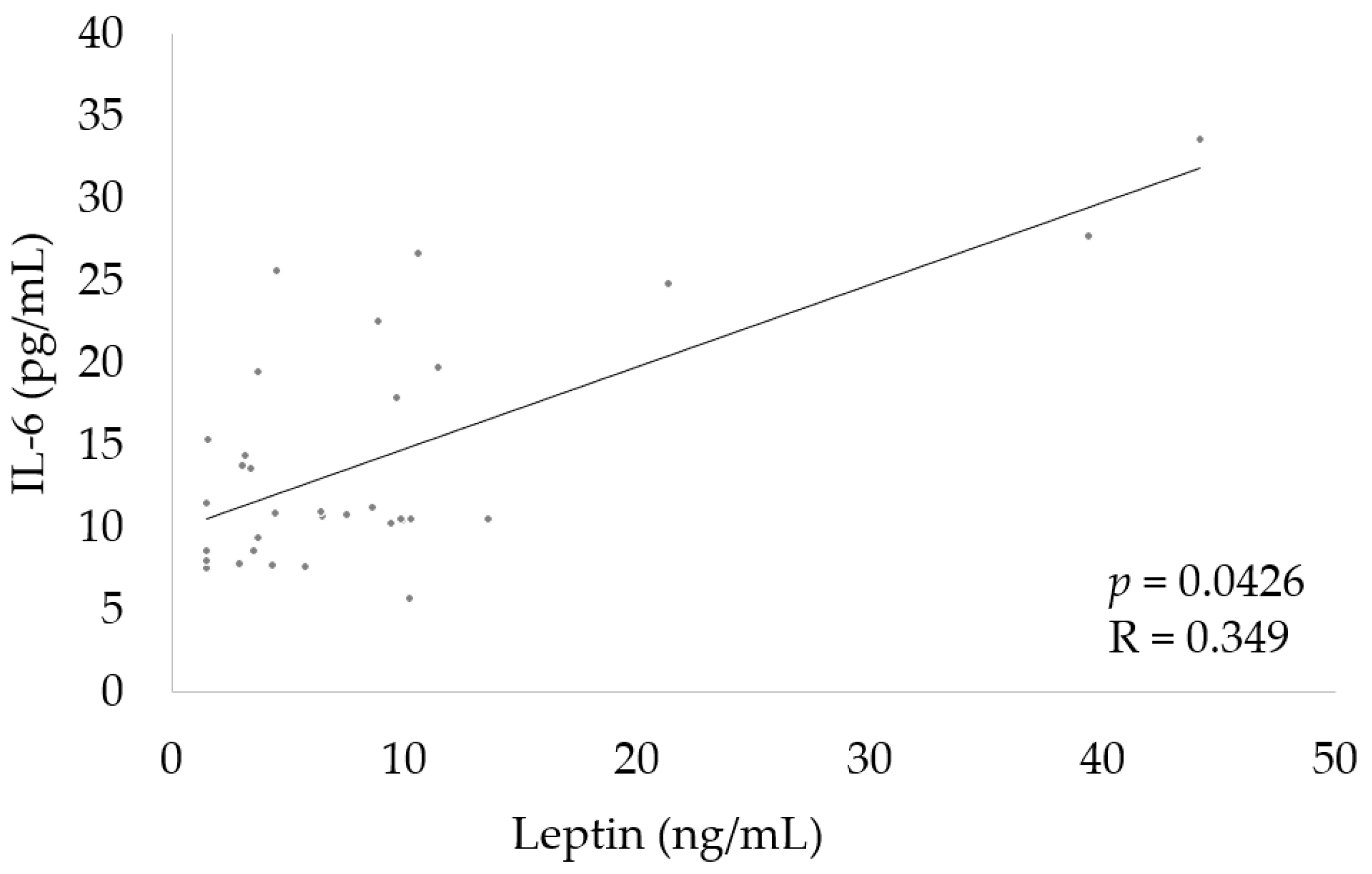Serum Appetite-Regulating Hormone Levels in Cystic Fibrosis Patients: Influence of the Disease Severity and the Type of Bacterial Infection—A Pilot Study
Abstract
1. Introduction
2. Materials and Methods
2.1. Ethical Issues
2.2. Study Design and Participants
2.3. Spirometry
2.4. Sputum Collection
2.5. Blood Sampling
2.6. Blood Counts and Serum Analysis
2.7. Appetite-Regulating Hormones Determination
2.8. Statistical Analyses
3. Results
4. Discussion
5. Conclusions
Author Contributions
Funding
Institutional Review Board Statement
Informed Consent Statement
Data Availability Statement
Conflicts of Interest
References
- Schluchter, M.D.; Konstan, M.W.; Drumm, M.L.; Yankaskas, J.R.; Knowles, M.R. Classifying Severity of Cystic Fibrosis Lung Disease Using Longitudinal Pulmonary Function Data. Am. J. Respir. Crit. Care Med. 2006, 174, 780–786. [Google Scholar] [CrossRef] [PubMed]
- Szczesniak, R.; Heltshe, S.L.; Stanojevic, S.; Mayer-Hamblett, N. Use of FEV1 in Cystic Fibrosis Epidemiologic Studies and Clinical Trials: A Statistical Perspective for the Clinical Researcher. J. Cyst. Fibros. 2017, 16, 318–326. [Google Scholar] [CrossRef] [PubMed]
- Galiniak, S.; Mołoń, M.; Rachel, M. Links between Disease Severity, Bacterial Infections and Oxidative Stress in Cystic Fibrosis. Antioxidants 2022, 11, 887. [Google Scholar] [CrossRef] [PubMed]
- Kerem, E.; Viviani, L.; Zolin, A.; MacNeill, S.; Hatziagorou, E.; Ellemunter, H.; Drevinek, P.; Gulmans, V.; Krivec, U.; Olesen, H. Factors Associated with FEV1 Decline in Cystic Fibrosis: Analysis of the ECFS Patient Registry. Eur. Respir. J. 2014, 43, 125–133. [Google Scholar] [CrossRef]
- Taylor-Robinson, D.; Whitehead, M.; Diderichsen, F.; Olesen, H.V.; Pressler, T.; Smyth, R.L.; Diggle, P. Understanding the Natural Progression in %FEV1 Decline in Patients with Cystic Fibrosis: A Longitudinal Study. Thorax 2012, 67, 860–866. [Google Scholar] [CrossRef]
- Earnest, A.; Salimi, F.; Wainwright, C.E.; Bell, S.C.; Ruseckaite, R.; Ranger, T.; Kotsimbos, T.; Ahern, S. Lung Function over the Life Course of Paediatric and Adult Patients with Cystic Fibrosis from a Large Multi-Centre Registry. Sci. Rep. 2020, 10, 17421. [Google Scholar] [CrossRef]
- Coutinho, H.D.M.; Falcão-Silva, V.S.; Gonçalves, G.F. Pulmonary Bacterial Pathogens in Cystic Fibrosis Patients and Antibiotic Therapy: A Tool for the Health Workers. Int. Arch. Med. 2008, 1, 24. [Google Scholar] [CrossRef]
- Chiappini, E.; Taccetti, G.; de Martino, M. Bacterial Lung Infections in Cystic Fibrosis Patients: An Update. Pediatr. Infect. Dis. J. 2014, 33, 653–654. [Google Scholar] [CrossRef]
- Patient Registry|Cystic Fibrosis Foundation. Available online: https://www.cff.org/medical-professionals/patient-registry (accessed on 19 September 2022).
- Bhagirath, A.Y.; Li, Y.; Somayajula, D.; Dadashi, M.; Badr, S.; Duan, K. Cystic Fibrosis Lung Environment and Pseudomonas aeruginosa Infection. BMC Pulm. Med. 2016, 16, 174. [Google Scholar] [CrossRef]
- John, A.; Goździk-Spychalska, J.; Durda-Masny, M.; Czaiński, W.; Pawłowska, N.; Wlizło, J.; Batura-Gabryel, H.; Szwed, A. Pseudomonas aeruginosa, the Type of Mutation, Lung Function, and Nutritional Status in Adults with Cystic Fibrosis. Nutrition 2021, 89, 111221. [Google Scholar] [CrossRef]
- Durda-Masny, M.; Goździk-Spychalska, J.; John, A.; Czaiński, W.; Stróżewska, W.; Pawłowska, N.; Wlizło, J.; Batura-Gabryel, H.; Szwed, A. The Determinants of Survival among Adults with Cystic Fibrosis—A Cohort Study. J. Physiol. Anthropol. 2021, 40, 19. [Google Scholar] [CrossRef] [PubMed]
- Galiniak, S.; Podgórski, R.; Rachel, M.; Mazur, A. Serum Leptin and Neuropeptide Y in Patients with Cystic Fibrosis—A Single Center Study. Front. Med. 2022, 9, 959584. [Google Scholar] [CrossRef] [PubMed]
- Cohen, R.I.; Tsang, D.; Koenig, S.; Wilson, D.; McCloskey, T.; Chandra, S. Plasma Ghrelin and Leptin in Adult Cystic Fibrosis Patients. J. Cyst. Fibros. 2008, 7, 398–402. [Google Scholar] [CrossRef] [PubMed]
- Galiniak, S.; Podgórski, R.; Rachel, M.; Mazur, A. Serum Levels of Hormones Regulating Appetite in Patients with Cystic Fibrosis—A Single-Center, Cross-Sectional Study. Front. Endocrinol. 2022, 13, 992667. [Google Scholar] [CrossRef] [PubMed]
- Beck, B. Neuropeptide Y in Normal Eating and in Genetic and Dietary-Induced Obesity. Philos. Trans. R. Soc. B Lond. Biol. Sci. 2006, 361, 1159–1185. [Google Scholar] [CrossRef]
- Liu, Y.; Albrecht, E.; Schering, L.; Kuehn, C.; Yang, R.; Zhao, Z.; Maak, S. Agouti Signaling Protein and Its Receptors as Potential Molecular Markers for Intramuscular and Body Fat Deposition in Cattle. Front. Physiol. 2018, 9, 172. [Google Scholar] [CrossRef]
- Voisey, J.; van Daal, A. Agouti: From Mouse to Man, from Skin to Fat. Pigment Cell Res. 2002, 15, 10–18. [Google Scholar] [CrossRef]
- Vehapoğlu, A.; Türkmen, S.; Terzioğlu, Ş. Alpha-Melanocyte-Stimulating Hormone and Agouti-Related Protein: Do They Play a Role in Appetite Regulation in Childhood Obesity? J. Clin. Res. Pediatr. Endocrinol. 2016, 8, 40–47. [Google Scholar] [CrossRef]
- Podgórski, R.; Galiniak, S.; Mazur, A.; Domin, A. The Association of the Hypothalamic-Pituitary-Adrenal Axis with Appetite Regulation in Children with Fetal Alcohol Spectrum Disorders (FASDs). Nutrients 2023, 15, 1366. [Google Scholar] [CrossRef]
- Millington, G.W. The Role of Proopiomelanocortin (POMC) Neurones in Feeding Behaviour. Nutr. Metab. 2007, 4, 18. [Google Scholar] [CrossRef]
- Böhm, M.; Grässel, S. Role of Proopiomelanocortin-Derived Peptides and Their Receptors in the Osteoarticular System: From Basic to Translational Research. Endocr. Rev. 2012, 33, 623–651. [Google Scholar] [CrossRef] [PubMed]
- Dudek, M.; Ziarniak, K.; Sliwowska, J.H. Kisspeptin and Metabolism: The Brain and Beyond. Front. Endocrinol. 2018, 9, 145. [Google Scholar] [CrossRef]
- Cahill, F.; Ji, Y.; Wadden, D.; Amini, P.; Randell, E.; Vasdev, S.; Gulliver, W.; Sun, G. The Association of Serum Total Peptide YY (PYY) with Obesity and Body Fat Measures in the CODING Study. PLoS ONE 2014, 9, e95235. [Google Scholar] [CrossRef] [PubMed]
- Graham, B.L.; Steenbruggen, I.; Miller, M.R.; Barjaktarevic, I.Z.; Cooper, B.G.; Hall, G.L.; Hallstrand, T.S.; Kaminsky, D.A.; McCarthy, K.; McCormack, M.C.; et al. Standardization of Spirometry 2019 Update. An Official American Thoracic Society and European Respiratory Society Technical Statement. Am. J. Respir. Crit. Care Med. 2019, 200, e70–e88. [Google Scholar] [CrossRef] [PubMed]
- Lee, T.W.R.; Brownlee, K.G.; Conway, S.P.; Denton, M.; Littlewood, J.M. Evaluation of a New Definition for Chronic Pseudomonas aeruginosa Infection in Cystic Fibrosis Patients. J. Cyst. Fibros. 2003, 2, 29–34. [Google Scholar] [CrossRef] [PubMed]
- Weinstein, M.P.; Patel, J.B. Methods for Dilution Antimicrobial Susceptibility Tests for Bacteria That Grow Aerobically: M07-A11, 11th ed.; Documents/Clinical and Laboratory Standards Institute; Committee for Clinical Laboratory Standards: Wayne, PA, USA, 2018; ISBN 978-1-56238-836-2. [Google Scholar]
- Soltman, S.; Hicks, R.A.; Naz Khan, F.; Kelly, A. Body Composition in Individuals with Cystic Fibrosis. J. Clin. Transl. Endocrinol. 2021, 26, 100272. [Google Scholar] [CrossRef] [PubMed]
- Nagy, R.; Gede, N.; Ocskay, K.; Dobai, B.-M.; Abada, A.; Vereczkei, Z.; Pázmány, P.; Kató, D.; Hegyi, P.; Párniczky, A. Association of Body Mass Index With Clinical Outcomes in Patients With Cystic Fibrosis: A Systematic Review and Meta-Analysis. JAMA Netw. Open 2022, 5, e220740. [Google Scholar] [CrossRef]
- Sheikh, S.; Zemel, B.S.; Stallings, V.A.; Rubenstein, R.C.; Kelly, A. Body Composition and Pulmonary Function in Cystic Fibrosis. Front. Pediatr. 2014, 2, 33. [Google Scholar] [CrossRef]
- Harindhanavudhi, T.; Wang, Q.; Dunitz, J.; Moran, A.; Moheet, A. Prevalence and Factors Associated with Overweight and Obesity in Adults with Cystic Fibrosis: A Single-Center Analysis. J. Cyst. Fibros. 2020, 19, 139–145. [Google Scholar] [CrossRef]
- Monajemzadeh, M.; Mokhtari, S.; Motamed, F.; Shams, S.; Ashtiani, M.T.H.; Abbasi, A.; Sani, M.N.; Sadrian, E. Plasma Ghrelin Levels in Children with Cystic Fibrosis and Healthy Children. Arch. Med. Sci. 2013, 9, 93–97. [Google Scholar] [CrossRef]
- Nowak, J.K.; Szczepanik, M.; Trypuć, M.; Pogorzelski, A.; Bobkowski, W.; Grytczuk, M.; Minarowska, A.; Wójciak, R.; Walkowiak, J. Circulating Brain-Derived Neurotrophic Factor, Leptin, Neuropeptide Y, and Their Clinical Correlates in Cystic Fibrosis: A Cross-Sectional Study. Arch. Med. Sci. 2020, 16, 1049–1056. [Google Scholar] [CrossRef] [PubMed]
- Galiniak, S.; Podgórski, R.; Rachel, M.; Mazur, A. Serum Kisspeptin and Proopiomelanocortin in Cystic Fibrosis: A Single Study. Sci. Rep. 2022, 12, 17669. [Google Scholar] [CrossRef] [PubMed]
- Qi, H.; Liu, H.; Zheng, P.; He, J. Lack of association between leptin concentrations and cystic fibrosis: A meta-analysis and regression. Front. Endocrinol. 2023, 14, 1126129. [Google Scholar] [CrossRef] [PubMed]
- Blackman, S.M.; Tangpricha, V. Endocrine Disorders in Cystic Fibrosis. Pediatr. Clin. N. Am. 2016, 63, 699–708. [Google Scholar] [CrossRef] [PubMed]
- Rachel, M.; Topolewicz, S.; Śliwczyński, A.; Galiniak, S. Managing Cystic Fibrosis in Polish Healthcare. Int. J. Environ. Res. Public Health 2020, 17, 7630. [Google Scholar] [CrossRef]
- Ahmed, M.; Ong, K.; Thomson, A.; Dunger, D. Reduced Gains in Fat and Fat-Free Mass, and Elevated Leptin Levels in Children and Adolescents with Cystic Fibrosis. Acta Paediatr. 2004, 93, 1185–1191. [Google Scholar] [CrossRef]
- Liang, R.; Zhang, W.; Song, Y.-M. Levels of Leptin and IL-6 in Lungs and Blood Are Associated with the Severity of Chronic Obstructive Pulmonary Disease in Patients and Rat Models. Mol. Med. Rep. 2013, 7, 1470–1476. [Google Scholar] [CrossRef]
- Mitri, C.; Xu, Z.; Bardin, P.; Corvol, H.; Touqui, L.; Tabary, O. Novel Anti-Inflammatory Approaches for Cystic Fibrosis Lung Disease: Identification of Molecular Targets and Design of Innovative Therapies. Front. Pharmacol. 2020, 11, 794854. [Google Scholar] [CrossRef]
- Finck, B.N.; Johnson, R.W. Tumor Necrosis Factor (TNF)-Alpha Induces Leptin Production through the P55 TNF Receptor. Am. J. Physiol. Regul. Integr. Comp. Physiol. 2000, 278, R537–R543. [Google Scholar] [CrossRef]
- Malhotra, S.; Hayes, D.; Wozniak, D.J. Cystic Fibrosis and Pseudomonas aeruginosa: The Host-Microbe Interface. Clin. Microbiol. Rev. 2019, 32, e00138-18. [Google Scholar] [CrossRef]
- Stelzer, I.; Zelzer, S.; Raggam, R.B.; Prüller, F.; Truschnig-Wilders, M.; Meinitzer, A.; Schnedl, W.J.; Horejsi, R.; Möller, R.; Weghuber, D.; et al. Link between Leptin and Interleukin-6 Levels in the Initial Phase of Obesity Related Inflammation. Transl. Res. 2012, 159, 118–124. [Google Scholar] [CrossRef] [PubMed]
- Pîrsean, C.; Neguț, C.; Staden, R.-I.S.; Dinu-Pirvu, C.E.; Armean, P.; Udeanu, D.I. The Salivary Levels of Leptin and Interleukin-6 as Potential Inflammatory Markers in Children Obesity. PLoS ONE 2019, 14, e0210288. [Google Scholar] [CrossRef] [PubMed]
- Chiu, C.Z.; Wang, B.W.; Shyu, K.G. Molecular regulation of the expression of leptin by hypoxia in human coronary artery smooth muscle cells. J. Biomed. Sci. 2015, 22, 5. [Google Scholar] [CrossRef] [PubMed]
- Grosfeld, A.; Zilberfarb, V.; Turban, S.; André, J.; Guerre-Millo, M.; Issad, T. Hypoxia increases leptin expression in human PAZ6 adipose cells. Diabetologia 2002, 45, 527–530. [Google Scholar] [CrossRef]
- Urquhart, D.S.; Montgomery, H.; Jaffé, A. Assessment of hypoxia in children with cystic fibrosis. Arch. Dis. Child. 2005, 90, 1138–1143. [Google Scholar] [CrossRef] [PubMed]
- Polito, R.; Nigro, E.; Elce, A.; Monaco, M.L.; Iacotucci, P.; Carnovale, V.; Comegna, M.; Gelzo, M.; Zarrilli, F.; Corso, G.; et al. Adiponectin Expression Is Modulated by Long-Term Physical Activity in Adult Patients Affected by Cystic Fibrosis. Mediat. Inflamm. 2019, 2019, 2153934. [Google Scholar] [CrossRef]
- Bouloumie, A.; Marumo, T.; Lafontan, M.; Busse, R. Leptin Induces Oxidative Stress in Human Endothelial Cells. FASEB J. 1999, 13, 1231–1238. [Google Scholar] [CrossRef]
- Schroyen, B.; Guimarães, E.L.; Dollé, L.; Coulon, S.; Empsen, C.; Nyssen, M.; Geerts, A.; Colle, I.; Geerts, A.; van Grunsven, L.A. Leptin-Mediated Reactive Oxygen Species Production Does Not Significantly Affect Primary Mouse Hepatocyte Functions in Vitro. Eur. J. Gastroenterol. Hepatol. 2012, 24, 1370–1380. [Google Scholar] [CrossRef]
- Berger, S.; Polotsky, V.Y. Leptin and Leptin Resistance in the Pathogenesis of Obstructive Sleep Apnea: A Possible Link to Oxidative Stress and Cardiovascular Complications. Oxid. Med. Cell. Longev. 2018, 2018, 5137947. [Google Scholar] [CrossRef]
- Moliteo, E.; Sciacca, M.; Palmeri, A.; Papale, M.; Manti, S.; Parisi, G.F.; Leonardi, S. Cystic Fibrosis and Oxidative Stress: The Role of CFTR. Molecules 2022, 27, 5324. [Google Scholar] [CrossRef]
- Wang, B.; Wood, I.S.; Trayhurn, P. Hypoxia Induces Leptin Gene Expression and Secretion in Human Preadipocytes: Differential Effects of Hypoxia on Adipokine Expression by Preadipocytes. J. Endocrinol. 2008, 198, 127–134. [Google Scholar] [CrossRef] [PubMed]
- Cohen, R.I.; Chandra, S.; Koenig, S.; Tsang, D.; Wilson, D.; McCloskey, T. Ghrelin Receptor Expression in Lymphocytes Isolated from Adult Cystic Fibrosis Patients. Respiration 2010, 79, 141–146. [Google Scholar] [CrossRef] [PubMed]



| CF | Healthy Controls | p | ||
|---|---|---|---|---|
| Sex (F/M) | 17/21 | 10/6 | ||
| Age (years) | mean ± SD | 19.6 ± 7.9 | 19.3 ± 7.3 | 0.855 |
| range | 10–39 | 10–38 | ||
| BMI (kg/m2), patients > 20 years | mean ± SD | 21.1 ± 2.9 | 23.2 ± 2.4 | 0.068 |
| range | 17.2–25.9 | 18.7–25.6 | ||
| BMI (Z-score), patients < 20 years | mean ± SD | −0.8 ± 1.1 | 0.2 ± 0.5 | 0.433 |
| range | −2.1–1.1 | −0.2–1 | ||
| Genotype | ||||
| Homozygous ΔF508, n (%) | 30 (78.9) | – | – | |
| Heterozygous ΔF508, n (%) | 8 (21.1) | – | – | |
| Clinical laboratory markers | ||||
| WBC (103/µL) | mean ± SD | 10 ± 3.6 | 7.5 ± 2.3 | 0.022 |
| range | 5.1–19.3 | 4.3–10.5 | ||
| NEU (%) | mean ± SD | 61 ± 15.3 | 59.1 ± 6.1 | 0.605 |
| range | 25.1–82.3 | 50.6–68.6 | ||
| Pulmonary function | ||||
| FEV1 (% predicted) | mean ± SD | 86.4 ± 27 | 102.4 ± 8.2 | 0.006 |
| range | 35–142 | 97–127 | ||
| Severity of disease | ||||
| Mild (FEV1 > 75%), n (%) | 23 (60.5) | – | – | |
| Moderate (FEV1 > 45%, <75%), n (%) | 9 (23.7) | – | – | |
| Severe (FEV1 < 45%), n (%) | 6 (15.8) | – | – | |
| Bacterial infection | ||||
| P. aeruginosa, n (%) | 9 (23.7) | – | – | |
| S. aureus, n (%) | 11 (28.9) | – | – | |
| Co–infected with P. aeruginosa and S. aureus, n (%) | 9 (23.7) | – | – | |
| Uninfected, n (%) | 9 (23.7) | 16 (100) | – | |
| Mild CF 10 F/13 M | Moderate CF 4 F/5 M | Severe CF 3 F/3 M | p | |
|---|---|---|---|---|
| Ghrelin (pg/mL) | 687.6 ± 197.4 (345.5–1070.5) | 556 ± 274.3 (192.3–828) | 616.2 ± 165.5 (419.3–785.1) | 0.428 |
| ASP (pg/mL) | 14 ± 2.1 (11.7–19.1) | 14.1 ± 2.2 (11.9–17.9) | 13.6 ± 2.9 (11.9–18.7) | 0.199 |
| NPY (pg/mL) | 290.1 ± 58 (167.6–381.6) | 271.5 ± 53.7 (211.1–376.4) | 242.7 ± 37.3 (210.6–300.2) | 0.596 |
| POMC (ng/mL) | 6.9 ± 4.8 (2–15.5) | 5.6 ± 3.1 (1.9–10.9) | 3.8 ± 2.4 (2.1–8) | 0.558 |
| KISS (ng/mL) | 1.8 ± 0.4 (1.1–3) | 1.5 ± 0.5 (1–2.2) | 1.6 ± 0.5 (1–2.2) | 0.073 |
| PYY (pg/mL) | 81.5 ± 17.5 (59.9–118.4) | 82.8 ± 22.8 (52.8–116.6) | 75.6 ± 23.9 (54.3–113.8) | 0.709 |
| α-MSH (pg/mL) | 13.9 ± 2.1 (10.4–17.1) | 13.1 ± 1.8 (10.3–15.1) | 14.6 ± 2.4 (12.4–17.2) | 0.317 |
| P. aeruginosa 5 F/4 M | S. aureus 4 F/7 M | Coinfected with P. aeruginosa and S. aures 4 F/5 M | Uninfected 4 F/5 M | p | |
|---|---|---|---|---|---|
| Ghrelin (pg/mL) | 605 ± 242.8 (192.3–828) | 634.3 ± 147.2 (435.1–1070.5) | 616.8 ± 240 (238.3–1013.8) | 829.7 ± 124.9 (682.3–1070.5) | 0.054 |
| ASP (pg/mL) | 14.9 ± 2.6 (11.9–18.7) | 14.4 ± 2.1 (12–17.9) | 13.9 ± 2.61 (11.7–19.1) | 13.4 ± 1.6 (12–16.5) | 0.349 |
| NPY (pg/mL) | 290.9 ± 63.4 (210.6–376.4) | 291.8 ± 44.4 (220.6–381.6) | 282 ± 60.7 (211.1–381.6) | 261.7 ± 61.2 (167.6–377.1) | 0.349 |
| POMC (ng/mL) | 5 ± 3.2 (2.1–10.9) | 5 ± 3.9 (2–15.5) | 6.7 ± 4.9 (1.9–14.6) | 8 ± 5 (2–15.5) | 0.349 |
| KISS (ng/mL) | 1.4 ± 0.3 (1–2.1) | 1.8 ± 0.4 (1.1–3) | 1.7 ± 0.6 (1.1–3) | 1.9 ± 0.4 (1.2–2.5) | 0.063 |
| PYY (pg/mL) | 72.6 ± 20.5 (54.3–116.6) | 82.7 ± 16.6 (60.7–118.4) | 74.2 ± 16.7 (52.8–101.6) | 89.2 ± 21 (61.3–118.4) | 0.437 |
| α-MSH (pg/mL) | 13 ± 2 (10.3–17.2) | 13.7 ± 1.8 (10.4–16.6) | 13.8 ± 2.5 (11–17.1) | 14.2 ± 2.3 (11.4–17.1) | 0.996 |
Disclaimer/Publisher’s Note: The statements, opinions and data contained in all publications are solely those of the individual author(s) and contributor(s) and not of MDPI and/or the editor(s). MDPI and/or the editor(s) disclaim responsibility for any injury to people or property resulting from any ideas, methods, instructions or products referred to in the content. |
© 2023 by the authors. Licensee MDPI, Basel, Switzerland. This article is an open access article distributed under the terms and conditions of the Creative Commons Attribution (CC BY) license (https://creativecommons.org/licenses/by/4.0/).
Share and Cite
Galiniak, S.; Podgórski, R.; Rachel, M.; Mazur, A. Serum Appetite-Regulating Hormone Levels in Cystic Fibrosis Patients: Influence of the Disease Severity and the Type of Bacterial Infection—A Pilot Study. Nutrients 2023, 15, 1851. https://doi.org/10.3390/nu15081851
Galiniak S, Podgórski R, Rachel M, Mazur A. Serum Appetite-Regulating Hormone Levels in Cystic Fibrosis Patients: Influence of the Disease Severity and the Type of Bacterial Infection—A Pilot Study. Nutrients. 2023; 15(8):1851. https://doi.org/10.3390/nu15081851
Chicago/Turabian StyleGaliniak, Sabina, Rafał Podgórski, Marta Rachel, and Artur Mazur. 2023. "Serum Appetite-Regulating Hormone Levels in Cystic Fibrosis Patients: Influence of the Disease Severity and the Type of Bacterial Infection—A Pilot Study" Nutrients 15, no. 8: 1851. https://doi.org/10.3390/nu15081851
APA StyleGaliniak, S., Podgórski, R., Rachel, M., & Mazur, A. (2023). Serum Appetite-Regulating Hormone Levels in Cystic Fibrosis Patients: Influence of the Disease Severity and the Type of Bacterial Infection—A Pilot Study. Nutrients, 15(8), 1851. https://doi.org/10.3390/nu15081851









